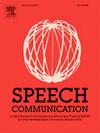使用1D-CNN进行文学和口语化泰米尔语分类的特征工程方法
IF 3
3区 计算机科学
Q2 ACOUSTICS
引用次数: 0
摘要
在理想的人机交互(HCI)中,语言的口语形式是大多数用户的首选,因为这是他们日常对话中使用的形式。然而,保留正式的文学形式也有不可否认的必要性。通过接纳新事物和保留旧事物,既可以为普通人服务(实用性),也可以为语言本身服务(保护)。因此,理想的情况是,计算机能够根据需要接受、处理和交流这两种语言。为了解决这个问题,首先有必要确定输入语音的形式,在目前的工作中,输入语音介于文学和口语化的泰米尔语之间。这样的前端系统必须包含一个简单、有效和轻量级的分类器,该分类器在能够捕获语音信号的底层模式的几个有效特征上进行训练。为了实现这一目标,提出了一种一维卷积神经网络(1D-CNN),该网络可以学习随时间变化的特征包络。该网络首先在选定数量的手工特征上进行训练,然后在Mel频率倒谱系数(MFCC)上进行比较。选择手工制作的特征来处理语音的各个方面,如频谱和时间特征,韵律和语音质量。首先分析十个平行话语的特征,观察每个特征随时间的变化趋势。使用手工特征训练的1D-CNN的F1分数为0.9803,而使用MFCC训练的1D-CNN的F1分数为0.9895。在此基础上,对特征消融和特征组合进行了探讨。将特征消融研究中排名最高的手工特征与MFCC相结合,F1得分为0.9946,结果最佳。本文章由计算机程序翻译,如有差异,请以英文原文为准。
A feature engineering approach for literary and colloquial Tamil speech classification using 1D-CNN
In ideal human computer interaction (HCI), the colloquial form of a language would be preferred by most users, since it is the form used in their day-to-day conversations. However, there is also an undeniable necessity to preserve the formal literary form. By embracing the new and preserving the old, both service to the common man (practicality) and service to the language itself (conservation) can be rendered. Hence, it is ideal for computers to have the ability to accept, process, and converse in both forms of the language, as required. To address this, it is first necessary to identify the form of the input speech, which in the current work is between literary and colloquial Tamil speech. Such a front-end system must consist of a simple, effective, and lightweight classifier that is trained on a few effective features that are capable of capturing the underlying patterns of the speech signal. To accomplish this, a one-dimensional convolutional neural network (1D-CNN) that learns the envelope of features across time, is proposed. The network is trained on a select number of handcrafted features initially, and then on Mel frequency cepstral coefficients (MFCC) for comparison. The handcrafted features were selected to address various aspects of speech such as the spectral and temporal characteristics, prosody, and voice quality. The features are initially analyzed by considering ten parallel utterances and observing the trend of each feature with respect to time. The proposed 1D-CNN, trained using the handcrafted features, offers an F1 score of 0.9803, while that trained on the MFCC offers an F1 score of 0.9895. In light of this, feature ablation and feature combination are explored. When the best ranked handcrafted features, from the feature ablation study, are combined with the MFCC, they offer the best results with an F1 score of 0.9946.
求助全文
通过发布文献求助,成功后即可免费获取论文全文。
去求助
来源期刊

Speech Communication
工程技术-计算机:跨学科应用
CiteScore
6.80
自引率
6.20%
发文量
94
审稿时长
19.2 weeks
期刊介绍:
Speech Communication is an interdisciplinary journal whose primary objective is to fulfil the need for the rapid dissemination and thorough discussion of basic and applied research results.
The journal''s primary objectives are:
• to present a forum for the advancement of human and human-machine speech communication science;
• to stimulate cross-fertilization between different fields of this domain;
• to contribute towards the rapid and wide diffusion of scientifically sound contributions in this domain.
 求助内容:
求助内容: 应助结果提醒方式:
应助结果提醒方式:


